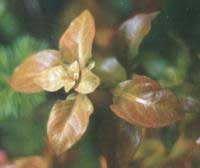HOME AQUARIUM
ENCYCLOPEDIA OF PLANTS
Ludwigia repens (Ludwigia creeping)

Family Onagraceae (Onagric).
Distribution of the USA, Mexico.
A marsh plant with above-water creeping, underwater erect, in knots forming roots shoots. The layout is opposite. Petiole to 1.2 cm, leaf blade very variable, above-water usually broadly elliptical, underwater from narrow to broadly elliptical, 2.0 to 3.5 cm long, 0.5 to 1.4 cm wide, olive green to green from below green Or wine-red color.
The flower is single, axillary, sedentary or with pedicel up to 5 mm. Bracts are linear, 3 - 5 mm long. Sepals are triangular, up to 4 mm. Petals somewhat less than equal to sepals of length, rapidly falling, yellow. 4 stamens, about 1 mm long. Pistil with stigma about the same length as the stamen. Fruit length of 5 - 8 mm, thickness 2 - 3 mm; Many-seeded. The number of chromosomes is n = 24.
Currently, many plant forms are cultivated from creeping ludwigia, which somewhat differ from each other in leaf form and coloration, but do not have a taxonomic discharge. All forms can be easily stored in the aquarium. They develop both in soft and hard water, for optimal growth, they need medium illumination and, if possible, a temperature below 26 degrees C. They are able to tolerate a higher temperature, but for a short time. The nutrient soil promotes the development of more powerful plants. The growth is so strong that it is necessary to cut the shoots regularly. It is recommended to use only the group in the middle or the back of the aquarium. For reliable identification, flowers are needed that are most often formed on the surface culture (sometimes underwater).
The species inhabits marshy areas.


Comments
Commenting on, remember that the content and tone of your message can hurt the feelings of real people, show respect and tolerance to your interlocutors even if you do not share their opinion, your behavior in the conditions of freedom of expression and anonymity provided by the Internet, changes Not only virtual, but also the real world. All comments are hidden from the index, spam is controlled.